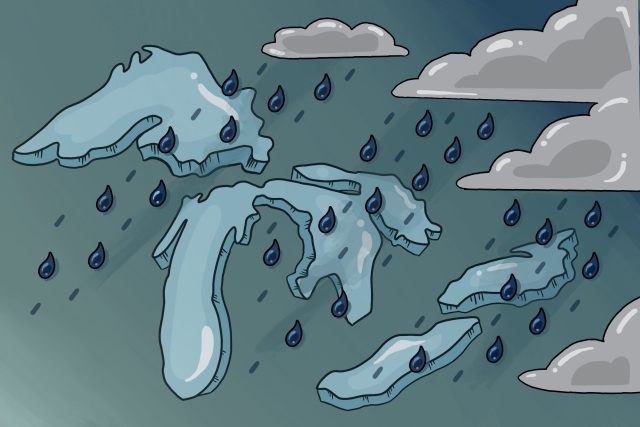[ad_1]
In a recent study conducted through the University of Michigan’s Cooperative Institute for Great Lakes Research, researchers have identified warming and shifting trends associated with winter weather systems in the Great Lakes region. The study, published in Geophysical Research Letters on Aug. 15, found that winter weather storm systems are rising in temperature, pushing them further northward and increasing precipitation in the region.
The researchers used historical data between 1959 and 2021 from the ERA5 atmospheric reanalysis dataset, which provides information on past atmospheric and oceanic conditions, to analyze trends in large winter storm systems in the Great Lakes region.
These winter storms, known as extratropical cyclones, were identified as either long-track ETCs that ran more than 2,000 kilometers for at least two days or short-track ETCs lasting fewer than two days. Shorter storms are typically not included in ETC studies, but they contribute to half of the 886 identified cyclones in this study. CIGLR researchers decided to include short-track ETCs because the smaller storms also impact the Great Lakes region, according to Ayumi Fujisaki-Manome, co-author of the study and associate research scientist at CIGLR. The study’s findings show that only short-track storms saw a statistically significant increase in rain over the years.
The researchers’ analysis suggests that ETCs are increasing in temperature, rising in moisture content and moving through more northern parts of the Great Lakes region.
The Great Lakes region holds a socioeconomic and cultural importance to its surrounding communities. According to the National Oceanic and Atmospheric Administration, which funded the study, the region provides over 30 million people with drinking water and produces a yearly gross domestic product of $3.1 trillion.
Fujisaki-Manome said the trends of ETCs, which could cause wintry mixes in upper parts of the region and melting snow and ice in others, could affect communities and shipping industries dependent on the lakes.
“We’re seeing a warming of these winter storms that are holding more moisture … it could lead to more flooding,” Fujisaki-Manome said. “Extratropical cyclones will not only have more moisture but also high winds, which could lead to storm surges for coastal areas.”
Ryan Glassman, a meteorologist who co-authored the study when he was an undergraduate at Valparaiso University, also said ETCs could lead to more flooding and mentioned more extreme precipitation events across the region.
“(Weather) does include more frequent warmer temperature extremes, (which) includes rain events for the lower Great Lakes region, so areas south of the University of Michigan … (and) greater instances of more mixed precipitation for the upper GLR,” Glassman said. “A concern about how these storms are getting warmer when they move into the (region) is that it could lead to decreased seasonal ice cover and increased risk of flooding.”
Fujisaki-Manome, Glassman and Abby Hutson, co-author of the study and an assistant research scientist at CIGLR, said they wanted to ensure that the warming changes in ETCs were not a result of the average warming of the regions they occurred in, known as the background climate. The researchers compared past changes in common statistics such as dew point, temperature and precipitation between ETCs and regional background climates.
Glassman said the composites revealed that the weather trends are tied to ETCs, which are warming at a faster rate than the background climate.
“Is this unique to the storms itself or the background climate?” Glassman said. “What we were able to find was that the GLR has been expecting warming trends, so we wanted to restrict some of those calculations and climatology within the boundaries to confidently identify those differences.”
The study found significant interannual variability in individual ETCs, meaning storm characteristics can still differ widely from season to season and additional research would need to be conducted on the trends. In an email to The Daily, AiLi Pigott, Environment and Sustainability graduate student and a geospatial data sciences specialization track leader for the School for Environment and Sustainability, said studies on the Great Lakes region are important not only to further examine this data but also to protect a region that provides for many coastal and non-coastal communities.
“The Great Lakes are the world’s largest freshwater system,” Pigott wrote. “Not only do the Great Lakes provide water for drinking and recreation, but they also have cultural, historical, economic and ecological value. As scientists, it is important to consider that our research provides a significant opportunity to collaborate across disciplines to develop innovative conservation strategies for the Great Lakes. These collaborative efforts not only ensure that future generations can continue to enjoy the Great Lakes, but also support the coastal communities in adapting and thriving in an ever changing world.”
Daily Staff Reporter Marissa Corsi can be reached at macorsi@umich.edu.
Related articles
[ad_2]
Source link











